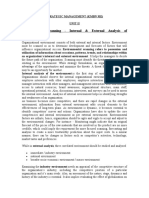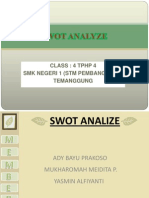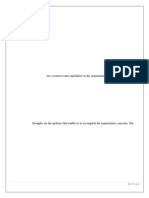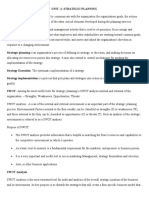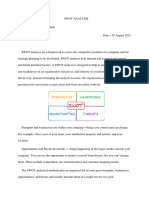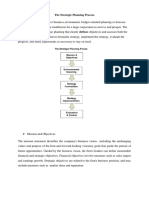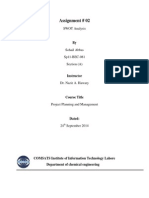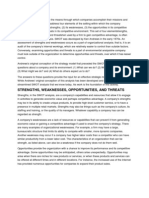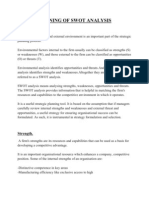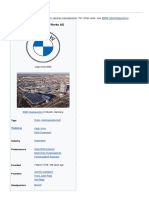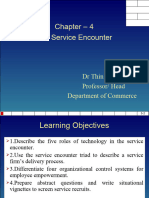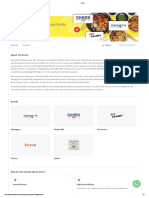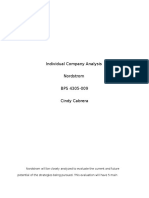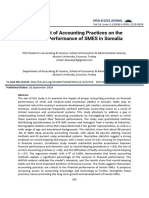SWOT Analysis - Definition, Advantages and Limitations
SWOT Analysis - Definition, Advantages and Limitations
Uploaded by
mackCopyright:
Available Formats
SWOT Analysis - Definition, Advantages and Limitations
SWOT Analysis - Definition, Advantages and Limitations
Uploaded by
mackOriginal Description:
Original Title
Copyright
Available Formats
Share this document
Did you find this document useful?
Is this content inappropriate?
Copyright:
Available Formats
SWOT Analysis - Definition, Advantages and Limitations
SWOT Analysis - Definition, Advantages and Limitations
Uploaded by
mackCopyright:
Available Formats
SWOT Analysis - Definition, Advantages and
Limitations
SWOT is an acronym for Strengths, Weaknesses, Opportunities and Threats. By definition, Strengths (S) and Weaknesses (W)
are considered to be internal factors over which you have some measure of control. Also, by definition, Opportunities (O) and Threats
(T) are considered to be external factors over which you have essentially no control.
SWOT Analysis is the most renowned tool for audit and analysis of the overall strategic position of the business and its environment.
Its key purpose is to identify the strategies that will create a firm specific business model that will best align an organization’s
resources and capabilities to the requirements of the environment in which the firm operates.
In other words, it is the foundation for evaluating the internal potential and limitations and the probable/likely opportunities and
threats from the external environment. It views all positive and negative factors inside and outside the firm that affect the success. A
consistent study of the environment in which the firm operates helps in forecasting/predicting the changing trends and also helps in
including them in the decision-making process of the organization.
An overview of the four factors (Strengths, Weaknesses, Opportunities and Threats) is given below-
1. Strengths - Strengths are the qualities that enable us to accomplish the organization’s mission. These are the basis on which
continued success can be made and continued/sustained.
Strengths can be either tangible or intangible. These are what you are well-versed in or what you have expertise in, the traits
and qualities your employees possess (individually and as a team) and the distinct features that give your organization its
consistency.
Strengths are the beneficial aspects of the organization or the capabilities of an organization, which includes human
competencies, process capabilities, financial resources, products and services, customer goodwill and brand loyalty.
Examples of organizational strengths are huge financial resources, broad product line, no debt, committed employees, etc.
2. Weaknesses - Weaknesses are the qualities that prevent us from accomplishing our mission and achieving our full potential.
These weaknesses deteriorate influences on the organizational success and growth. Weaknesses are the factors which do not
meet the standards we feel they should meet.
Weaknesses in an organization may be depreciating machinery, insufficient research and development facilities, narrow
product range, poor decision-making, etc. Weaknesses are controllable. They must be minimized and eliminated. For
instance - to overcome obsolete machinery, new machinery can be purchased. Other examples of organizational weaknesses
are huge debts, high employee turnover, complex decision making process, narrow product range, large wastage of raw
materials, etc.
3. Opportunities - Opportunities are presented by the environment within which our organization operates. These arise when
an organization can take benefit of conditions in its environment to plan and execute strategies that enable it to become more
profitable. Organizations can gain competitive advantage by making use of opportunities.
Organization should be careful and recognize the opportunities and grasp them whenever they arise. Selecting the targets that
will best serve the clients while getting desired results is a difficult task. Opportunities may arise from market, competition,
industry/government and technology. Increasing demand for telecommunications accompanied by deregulation is a great
opportunity for new firms to enter telecom sector and compete with existing firms for revenue.
4. Threats - Threats arise when conditions in external environment jeopardize the reliability and profitability of the
organization’s business. They compound the vulnerability when they relate to the weaknesses. Threats are uncontrollable.
When a threat comes, the stability and survival can be at stake. Examples of threats are - unrest among employees; ever
changing technology; increasing competition leading to excess capacity, price wars and reducing industry profits; etc.
Advantages of SWOT Analysis
SWOT Analysis is instrumental in strategy formulation and selection. It is a strong tool, but it involves a great subjective element. It is
best when used as a guide, and not as a prescription. Successful businesses build on their strengths, correct their weakness and protect
against internal weaknesses and external threats. They also keep a watch on their overall business environment and recognize and
exploit new opportunities faster than its competitors.
SWOT Analysis helps in strategic planning in following manner-
a. It is a source of information for strategic planning.
b. Builds organization’s strengths.
c. Reverse its weaknesses.
d. Maximize its response to opportunities.
e. Overcome organization’s threats.
f. It helps in identifying core competencies of the firm.
g. It helps in setting of objectives for strategic planning.
h. It helps in knowing past, present and future so that by using past and current data, future plans can be chalked out.
SWOT Analysis provide information that helps in synchronizing the firm’s resources and capabilities with the competitive
environment in which the firm operates.
SWOT ANALYSIS FRAMEWORK
Limitations of SWOT Analysis
SWOT Analysis is not free from its limitations. It may cause organizations to view circumstances as very simple because of which the
organizations might overlook certain key strategic contact which may occur. Moreover, categorizing aspects as strengths, weaknesses,
opportunities and threats might be very subjective as there is great degree of uncertainty in market. SWOT Analysis does stress upon
the significance of these four aspects, but it does not tell how an organization can identify these aspects for itself.
There are certain limitations of SWOT Analysis which are not in control of management. These include-
a. Price increase;
b. Inputs/raw materials;
c. Government legislation;
d. Economic environment;
e. Searching a new market for the product which is not having overseas market due to import restrictions; etc.
Internal limitations may include-
a. Insufficient research and development facilities;
b. Faulty products due to poor quality control;
c. Poor industrial relations;
d. Lack of skilled and efficient labour; etc
You might also like
- Vans Pestel AnalysisDocument3 pagesVans Pestel AnalysisTuma Daoud100% (1)
- The SWOT Analysis: A key tool for developing your business strategyFrom EverandThe SWOT Analysis: A key tool for developing your business strategyRating: 3.5 out of 5 stars3.5/5 (10)
- Dairy Farm Project Report - Buffalo (Large Scale) - Project ReportDocument2 pagesDairy Farm Project Report - Buffalo (Large Scale) - Project ReportVinod JagdaleNo ratings yet
- SWOT Analysis - Definition, Advantages and LimitationsDocument4 pagesSWOT Analysis - Definition, Advantages and LimitationsMohd Aizuddin JerryNo ratings yet
- Strength Weakness Opportunity & Threat - SWOT AnalysisDocument3 pagesStrength Weakness Opportunity & Threat - SWOT AnalysisSurabhi Kapadekar100% (3)
- SWOT AnalysisDocument4 pagesSWOT AnalysisNishu KatiyarNo ratings yet
- SWOT Analysis: SWOT Is An Acronym For Strengths, Weaknesses, Opportunities and ThreatsDocument14 pagesSWOT Analysis: SWOT Is An Acronym For Strengths, Weaknesses, Opportunities and ThreatsAnonymous h6DhpqWA9No ratings yet
- Swot - STMDocument3 pagesSwot - STMrajeeevaNo ratings yet
- Introduction of The Topic: SWOT Analysis (Alternatively SWOT Matrix) Is An Acronym For Strengths, WeaknessDocument59 pagesIntroduction of The Topic: SWOT Analysis (Alternatively SWOT Matrix) Is An Acronym For Strengths, WeaknessStarNo ratings yet
- SM 2 UnitDocument27 pagesSM 2 UnitANKUR CHOUDHARYNo ratings yet
- Swot Def, Av PDFDocument8 pagesSwot Def, Av PDFCaty TudoseNo ratings yet
- SwotDocument15 pagesSwotAdy Bayu PrakosoNo ratings yet
- Unit 4Document41 pagesUnit 4Karan EvangelineNo ratings yet
- SWOT AnalysisDocument7 pagesSWOT AnalysisNaveen Kishore GattimNo ratings yet
- Strategic Planning (Unit-2)Document14 pagesStrategic Planning (Unit-2)jalaja munirajuNo ratings yet
- CHA2 - Strategic MGMTDocument20 pagesCHA2 - Strategic MGMTAbdoul Shakour NeyaNo ratings yet
- Class Notes - SWOT AnalysisDocument6 pagesClass Notes - SWOT Analysismahima singhNo ratings yet
- Strategy ManagementDocument17 pagesStrategy Managementsubin100% (2)
- Strategic Management - Unit 2 & 3Document39 pagesStrategic Management - Unit 2 & 3Priyanshu Ranjan PandeyNo ratings yet
- What Are The Steps To Perform A Strategic Analysis?Document3 pagesWhat Are The Steps To Perform A Strategic Analysis?Fathi Fathu100% (1)
- Why Use SWOT AnalysisDocument5 pagesWhy Use SWOT AnalysisᎩᎧᎶᏋᏕᏂ ᏠᎧᏕᏂᎥNo ratings yet
- SWOT Analysis: - These Are The Qualities That Enable To Accomplish The Organization's Mission. TheseDocument3 pagesSWOT Analysis: - These Are The Qualities That Enable To Accomplish The Organization's Mission. TheseAlessandro MuragliaNo ratings yet
- Swot Analysis and Organizational Development in The Nigerian Public ServiceDocument14 pagesSwot Analysis and Organizational Development in The Nigerian Public ServiceShah JeeNo ratings yet
- S Wort ProjectDocument37 pagesS Wort ProjectPari SavlaNo ratings yet
- ManagementDocument7 pagesManagementbeshahashenafe20No ratings yet
- Swot AnalysisDocument5 pagesSwot AnalysisankitaapsychNo ratings yet
- What Is SWOT AnalysisDocument4 pagesWhat Is SWOT AnalysisParul RanaNo ratings yet
- Analysis of Internal and External EnvironmentDocument2 pagesAnalysis of Internal and External EnvironmentFernandes RudolfNo ratings yet
- Swot and TowsDocument4 pagesSwot and Towsiamyzn56No ratings yet
- SWOT & TOWS MatrixDocument6 pagesSWOT & TOWS Matrixs17005832No ratings yet
- Week-2-MGTDocument8 pagesWeek-2-MGTkristallabonite15No ratings yet
- Marketing Management - SWOT AnalysisDocument8 pagesMarketing Management - SWOT AnalysissakhawatNo ratings yet
- The Strategic Planning ProcessDocument10 pagesThe Strategic Planning ProcessSyed Faiz QuadriNo ratings yet
- Lecture On SWOT AnalysisDocument32 pagesLecture On SWOT AnalysisDasarathan Rajaraman100% (1)
- The Structure of A Good SWOT - How To Do It Right - SMIDocument11 pagesThe Structure of A Good SWOT - How To Do It Right - SMIhisham hussainNo ratings yet
- A Study of Strategic MGMT On AmulDocument35 pagesA Study of Strategic MGMT On AmulDilshaad ShaikhNo ratings yet
- Swot and TowsDocument4 pagesSwot and TowsVaibhavNo ratings yet
- m1 SWOT-ANALYSISDocument2 pagesm1 SWOT-ANALYSISAbduirazak ZeindineNo ratings yet
- Lecture 2 Aditional Reading SWOT PEST 3C's Porter Generic 5 FactorsDocument29 pagesLecture 2 Aditional Reading SWOT PEST 3C's Porter Generic 5 FactorsMacqwin FernandesNo ratings yet
- Module 3 Tools For Case Analysis PDFDocument21 pagesModule 3 Tools For Case Analysis PDFMahua Adak MandalNo ratings yet
- Good AfternoonDocument12 pagesGood AfternoonMatt Lawrence BerdinNo ratings yet
- SWOT iPhoneDocument14 pagesSWOT iPhonearhamkhan5222No ratings yet
- SM Module 2Document14 pagesSM Module 2Nikhat ShaikhNo ratings yet
- SWOT AnalysisDocument12 pagesSWOT AnalysisAdrian DominoNo ratings yet
- LESSON 1: Environment AnalysisDocument10 pagesLESSON 1: Environment AnalysisApril Joy DelacruzNo ratings yet
- Strategic ManagementDocument3 pagesStrategic Managementapriljoydaradar9No ratings yet
- SWOT AnalysisDocument10 pagesSWOT AnalysisDipanjan DasNo ratings yet
- Hul Final2Document34 pagesHul Final2Ahsan Abdul Rashid KhanNo ratings yet
- Strategic MGMTDocument22 pagesStrategic MGMTRaj ThakurNo ratings yet
- Concept Paper About Swot Analysis SystemDocument9 pagesConcept Paper About Swot Analysis SystemPius VirtNo ratings yet
- Term Paper 515Document8 pagesTerm Paper 515toja_hNo ratings yet
- SWOT AnalysisDocument6 pagesSWOT Analysisabbas_sohail110100% (1)
- SEC ASSINGMENT (1)Document17 pagesSEC ASSINGMENT (1)Gaurang KanojiaNo ratings yet
- Strengths, Weaknesses, Opportunities, and ThreatsDocument4 pagesStrengths, Weaknesses, Opportunities, and ThreatsNagina ShaheenNo ratings yet
- Analiza SWOTDocument6 pagesAnaliza SWOTBobeica Madalina MariaNo ratings yet
- SWOT Analysis 1Document8 pagesSWOT Analysis 1Myint FrancoNo ratings yet
- Unit 2Document43 pagesUnit 2Atul KumarNo ratings yet
- Swot AnalysisDocument4 pagesSwot Analysissoundousred66No ratings yet
- SOWT Analysis EDocument6 pagesSOWT Analysis Emakarioshany997No ratings yet
- SHRMDocument10 pagesSHRMJames GikingoNo ratings yet
- Zain JavedDocument4 pagesZain JavedRao QadirNo ratings yet
- VodafoneDocument4 pagesVodafonebawamatharooNo ratings yet
- Zodiac: For The East Asian Zodiac Based On The Jovian Orbital Cycle, See - For Other Uses, SeeDocument5 pagesZodiac: For The East Asian Zodiac Based On The Jovian Orbital Cycle, See - For Other Uses, SeemackNo ratings yet
- Astrological Sign: Western Zodiac SignsDocument3 pagesAstrological Sign: Western Zodiac SignsmackNo ratings yet
- House (Astrology) : The Four Bhavas of Hindu AstrologyDocument2 pagesHouse (Astrology) : The Four Bhavas of Hindu AstrologymackNo ratings yet
- Cancer (Astrology) : BackgroundDocument2 pagesCancer (Astrology) : BackgroundmackNo ratings yet
- BMW History LessonsDocument4 pagesBMW History LessonsmackNo ratings yet
- Volvo History LessionDocument3 pagesVolvo History LessionmackNo ratings yet
- SWOT in New AgeDocument3 pagesSWOT in New AgemackNo ratings yet
- HULDocument103 pagesHULEven You, CanNo ratings yet
- Cooperation and CollaborationDocument3 pagesCooperation and CollaborationShubhangi MaheshNo ratings yet
- Ch-4 The Service EncounterDocument25 pagesCh-4 The Service Encountertraining.manager.dmmNo ratings yet
- MOSt Stocks DiwaliDocument6 pagesMOSt Stocks DiwaliSuresh Babu ANo ratings yet
- Midterm Exam (Reviewer)Document84 pagesMidterm Exam (Reviewer)Mj PamintuanNo ratings yet
- Analysis of Financial Statements of Tata Steel: Bachelor of Business AdministrationDocument5 pagesAnalysis of Financial Statements of Tata Steel: Bachelor of Business Administrationvarun rajNo ratings yet
- INVENTORY PROBLEMS AND CONCEPTS QUE and ANSDocument11 pagesINVENTORY PROBLEMS AND CONCEPTS QUE and ANSMALICDEM, CharizNo ratings yet
- AzureDocument5 pagesAzuresudhanshuNo ratings yet
- MCQ of Corporate Accounting SEM 3Document2 pagesMCQ of Corporate Accounting SEM 3Sumit AcharyaNo ratings yet
- CH - 2 For BETDocument13 pagesCH - 2 For BETEtana WirtuNo ratings yet
- Chapter 6 Output and CostDocument6 pagesChapter 6 Output and CostCassy SisnorioNo ratings yet
- MasterbudgetDocument154 pagesMasterbudgetrochielanciolaNo ratings yet
- Nordstrom Research AnalysisDocument19 pagesNordstrom Research AnalysisCindy Cabrera100% (2)
- Audit of LiabilitiesDocument62 pagesAudit of LiabilitiesだみNo ratings yet
- Curriculum Vitae: Nicola PavoniDocument6 pagesCurriculum Vitae: Nicola PavoniDeni djbNo ratings yet
- Export-Import Theory: Belay, S. (2009) - Export-Import Theory, Practices, and Procedures. (2 Ed.) - New York: RoutledgeDocument6 pagesExport-Import Theory: Belay, S. (2009) - Export-Import Theory, Practices, and Procedures. (2 Ed.) - New York: RoutledgePaty GomezNo ratings yet
- Bms Sir Zia Practice QuestionsDocument50 pagesBms Sir Zia Practice QuestionsRana gNo ratings yet
- Pengaruh Social Media Marketing, Brand Awareness, Dan Brand Image TerhadapDocument13 pagesPengaruh Social Media Marketing, Brand Awareness, Dan Brand Image Terhadapdestya renata ramadhiniNo ratings yet
- Case Digest 2nd BatchDocument18 pagesCase Digest 2nd BatchTeacherEliNo ratings yet
- Task 1 Lesson 1 Organization Company StructureDocument2 pagesTask 1 Lesson 1 Organization Company StructuremariaNo ratings yet
- (Document) Math Written Report Application of DerivatesDocument9 pages(Document) Math Written Report Application of DerivatespanganibanbeaNo ratings yet
- Chapter 3Document30 pagesChapter 3MorerpNo ratings yet
- Macroeconomics Assignment-1Document2 pagesMacroeconomics Assignment-1Beza GetachewNo ratings yet
- Addis Ababa Science & Technology University College of Architectural & Civil Engineering EngineeringDocument14 pagesAddis Ababa Science & Technology University College of Architectural & Civil Engineering Engineeringh100% (1)
- Critical Analysis of Pakistan Trade Policy 2015 - 2018Document11 pagesCritical Analysis of Pakistan Trade Policy 2015 - 2018TayyabNo ratings yet
- 10 1002@sd 2118Document11 pages10 1002@sd 2118danie.arti01No ratings yet
- Tally ManualDocument80 pagesTally ManualVishnu VardhanNo ratings yet
- The Impact of Accounting Practices On The Financial Performance of Smes in SomaliaDocument21 pagesThe Impact of Accounting Practices On The Financial Performance of Smes in Somalialibanaly23No ratings yet









